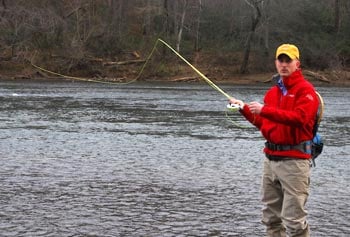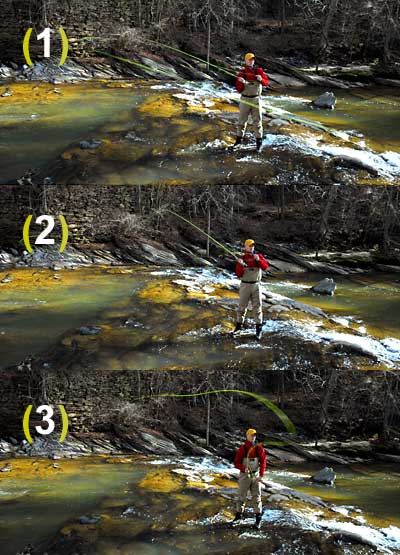The Belgian Cast
 HIGH WATER ON IDAHO’S Big Lost River was forcing me to play a game I don’t usually enjoy. The fish were deep and stodgy, and they wanted something dead-drifted. Their message was clear: No streamer madness, no hopper-dropper today; just tie a stone fly nymph to an anvil and feed us! So out came a size 6 Kaufmann’s Stone and my biggest strike indicator. I rigged up the 6-weight rod, dusted off my Belgian cast and started catching fish.
HIGH WATER ON IDAHO’S Big Lost River was forcing me to play a game I don’t usually enjoy. The fish were deep and stodgy, and they wanted something dead-drifted. Their message was clear: No streamer madness, no hopper-dropper today; just tie a stone fly nymph to an anvil and feed us! So out came a size 6 Kaufmann’s Stone and my biggest strike indicator. I rigged up the 6-weight rod, dusted off my Belgian cast and started catching fish.
Keep It Moving
The Belgian cast differs in two important ways from the technique that most beginners learned on Day One. First, it is a constant-motion cast. The rod never stops until it’s time to lay the cast down, and during the stroke the rod is always loaded. Second, the rod doesn’t move in a straight line or through a single plane. Instead, the backcast is consciously made in a more horizontal plane than the forward cast. Because the rod rounds and blends the boundaries between backcast and forward cast, the Belgian is rounded in every way possible. Mel Krieger aptly calls it a “pull-around, swing-around” cast. It is this roundedness that gives it great grace and justifies associations with exquisite Belgian chocolates.
I had to dust off my Belgian cast on the Big Lost because I don’t often hurl heavy artillery, such as Kaufmann’s Stones, at trout. But it’s the perfect cast for ultra-heavy flies. It’s also the cast of choice for heaving a sinking shooting head. To cast heavy flies and dense lines, you need an open loop, constant tension on the rod, and the somewhat horizontal backcast to keep the fly away from your head. Even if you haven’t heard of the Belgian cast before reading this, you may have subconsciously devised something like it as a way to cast these dense flies and lines.
 You may have heard of this cast by other names, such as oval, elliptical, tension, or circular. They’re all synonyms for the Belgian. More and more beginners are learning it these days as a way to cast the two-fly rigs that have become ubiquitous on some rivers. By opening the loop and making the backcast more horizontal than the forward cast, you reduce the amount of tangling that these rigs invite. The longer your leader and lighter your trailing fly, the more you’ll need this cast, as you will if you are fishing with nearly any strike indicator. Heavy flies, dense sinking lines, strike-indicator fishing, and two-fly rigs all have this in common: they are hostile to tight-loop casting, with its precise stops and crisp turnover. Instead, they work best with wide loops and languid turnover. At this the Belgian excels.
You may have heard of this cast by other names, such as oval, elliptical, tension, or circular. They’re all synonyms for the Belgian. More and more beginners are learning it these days as a way to cast the two-fly rigs that have become ubiquitous on some rivers. By opening the loop and making the backcast more horizontal than the forward cast, you reduce the amount of tangling that these rigs invite. The longer your leader and lighter your trailing fly, the more you’ll need this cast, as you will if you are fishing with nearly any strike indicator. Heavy flies, dense sinking lines, strike-indicator fishing, and two-fly rigs all have this in common: they are hostile to tight-loop casting, with its precise stops and crisp turnover. Instead, they work best with wide loops and languid turnover. At this the Belgian excels.
Getting Started
As a reference point, start by making some 40-foot pickup-laydown casts in your normal casting style, the way you’d cast a dry fly. Be sure to make the forward casts stop with the rod pointing well above the horizon. Now feel the difference of the Belgian cast. During the backcast, make the rod move as though you’re swinging a searchlight just above horizontal, through some nearby trees. During the forward cast, swing the searchlight through the sky almost directly overhead. (Keep the rod tilted a bit off-vertical as you come forward to avoid hitting yourself in the back of the head with your practice-yarn fly.) In order to make a smooth transition from a near-horizontal backcast to a near-vertical forward cast, you’ll notice that you cannot make a crisp backcast stop. Do 10 or 20 of these with your eyes on your forward cast. If the forward cast fails to extend, it may be because you need to stop the forward cast with the rod pointing at the tops of the trees rather than at the trunks.
Repeat this drill of 10 to 20 casts, but this time close your eyes. You should feel that your rod is in constant motion. You should also feel the line’s tension on the rod throughout the stroke and that the rod doesn’t unload until after your forward stop.
At this point, experiment with the size of the loop. Do this by imagining that your rod is drawing the edges of a giant egg —it’s three feet long — that levitates rod-side with the long axis in the direction of the cast. Your backcast draws the outside edge of the egg and your forward cast draws the edge nearest your ear. To change the size of your loop, make the egg skinnier or fatter. For very heavy flies or bulky strike indicators, you’ll make the egg very fat. When fishing a hopper with a small, light nymph trailing behind, you’ll only need to draw a skinny egg.
The Belgian is also useful on breezy days. You can use it to pickup and backcast a hopper-and-dropper almost horizontally on your upwind side and make the forward cast with the rod butt traveling over your head on the forward cast. By pointing the rod downwind during the forward cast, you prevent the flies from being blown into you or the rod during the forward stroke. So try some casts where the egg now sits on top of your head. Make the backcast along the egg’s upwind edge. Make the forward cast along the egg’s downwind edge, with your tip-top passing over your left shoulder. If you’ve never cast this way before, with the rod butt traveling over your head during the forward stroke, this cast will feel quite awkward at first. However, I promise that after about 20 or so repetitions, it will become more comfortable.
Here is one final drill: As you round the back end of the egg from backcast to forward cast, elevate your rod hand gently and slightly by lifting your elbow. This is called drift. It’s a technique normally used in distance casting because it lengthens the forward stroke, which is useful during a Belgian cast. All that rounding of the loop slows down the loop as it unrolls in back. To be sure that you’ve pulled all the slack out of the line after the backcast’s lazy turnover, a longer forward stroke will help to straighten the line fully in front. This is especially helpful when circumstances warrant using the Belgian but you need to really push out far to reach the fish. Drifting will always help your distance, and we’ll look at it in more detail in a future article.
The Belgian cast will help you in a lot of situations, from technical trout fishing with strike indicators to launching huge flies in the surf with shooting heads. It may not have come from Belgium but it’ll certainly make you a more worldly fly fisher.











